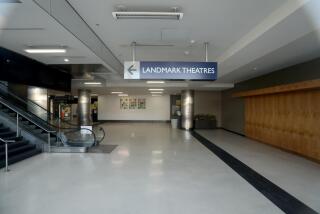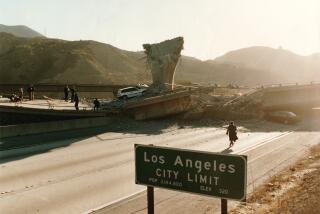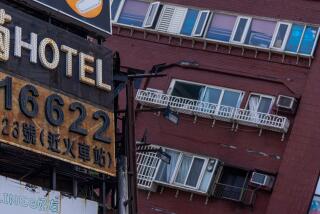EARTHQUAKE / THE ROAD TO RECOVERY : International Visitors Look for the Lessons in L.A.’s Disaster : Aftermath: Government officials come to study how federal, state and local agencies responded after the temblor.
- Share via
The quick response and coordinated effort by federal, state and local government officials to provide assistance to victims of the Northridge earthquake has drawn the attention of the world.
In recent weeks, government officials from Canada, Korea, Germany, France, Argentina, Chile and Taiwan have visited disaster relief centers and earthquake damage sites to study the way officials here have responded to the emergency.
“They are observing what we are doing here to see if they can use any of it in their countries,” said Fred Messick, a spokesman for the Governor’s Office of Emergency Services, which jointly manages Earthquake Service Centers with the Federal Emergency Management Agency.
On Monday, a group from India is scheduled to visit with both OES and FEMA officials to exchange information about earthquake preparedness and post-disaster assistance. Last September in India, the rural area of Killari experienced a magnitude 6.4 quake, which killed nearly 30,000 people. The 6.8-magnitude Northridge quake Jan. 17 resulted in 57 deaths.
Last week, 30 government officials from Japan visited an Earthquake Service Center in Chatsworth. They represent Japan’s ministries of health and welfare, transport, posts and telecommunications and construction, as well as Japan’s Fire Defense Agency, National Land Agency, Science and Technology Agency and National Police Agency.
Yukihiko Sumiyoshi of Japan’s Ministry of Construction explained that the group arrived in Los Angeles on Tuesday for a one-week stay. From here, the group will travel to Sacramento.
The Japanese officials visited the collapsed Santa Monica Freeway, the crushed Northridge Meadows Apartments building, the devastation along Ventura Boulevard in Sherman Oaks and a destroyed mobile home park in Sylmar.
Before last week’s tour of the service center, the group was briefed by a Small Business Administration representative, a psychologist and a FEMA earthquake mitigation expert.
The visitors appeared to be fascinated by the cooperative effort of the different federal, state and local agencies, all housed in the service center.
“How do you share all the people?” asked one man.
Koji Miura of the Ministry of Health and Welfare said that Japan does not have a coordinated effort similar to FEMA’s, but that it could work in his country.
“We are learning about what the people in California are doing,” Miura said. “It is very interesting.”
Another man was confused about the transition from Disaster Assistance Centers to Earthquake Service Centers.
“You do this only for earthquakes?” he asked. “What about hurricanes?”
It was explained that DACs are set up to assist victims in applying for government aid in all major disasters. Then, service centers provide follow-up help for those who have applied for help at a DAC. In this case, earthquake was added to the service centers’ name because that was the local disaster, officials explained.
After the tour, the Japanese delegation appeared impressed.
“This is a very good service for the people,” Sumiyoshi said. “The government agencies work hard and quickly to help the people.”
More to Read
Sign up for Essential California
The most important California stories and recommendations in your inbox every morning.
You may occasionally receive promotional content from the Los Angeles Times.










